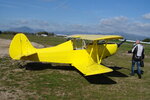The Basket
Senior Master Sergeant
- 3,712
- Jun 27, 2007
I saw an airplane and I was thinking why isn't that a biplane?
So why do all modern general aviation have single wings?
The top speed of these aircraft are negligible so drag isn't an issue.
But better STOL and stalling speed would be a great boon.
So why do all modern general aviation have single wings?
The top speed of these aircraft are negligible so drag isn't an issue.
But better STOL and stalling speed would be a great boon.

